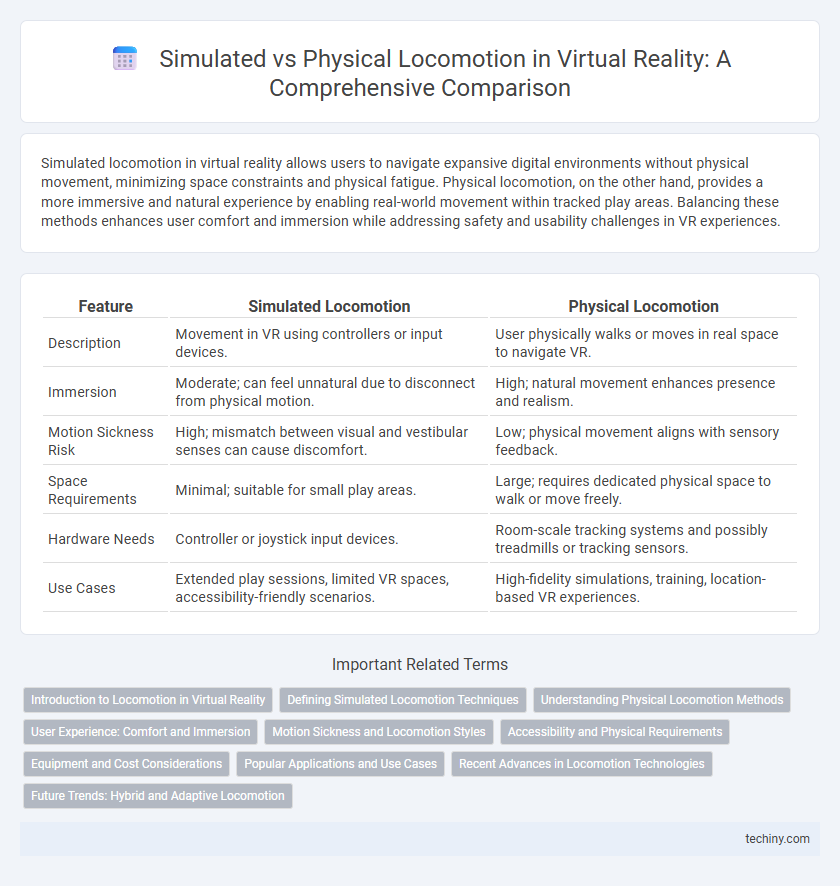Simulated locomotion in virtual reality allows users to navigate expansive digital environments without physical movement, minimizing space constraints and physical fatigue. Physical locomotion, on the other hand, provides a more immersive and natural experience by enabling real-world movement within tracked play areas. Balancing these methods enhances user comfort and immersion while addressing safety and usability challenges in VR experiences.
Table of Comparison
| Feature | Simulated Locomotion | Physical Locomotion |
|---|---|---|
| Description | Movement in VR using controllers or input devices. | User physically walks or moves in real space to navigate VR. |
| Immersion | Moderate; can feel unnatural due to disconnect from physical motion. | High; natural movement enhances presence and realism. |
| Motion Sickness Risk | High; mismatch between visual and vestibular senses can cause discomfort. | Low; physical movement aligns with sensory feedback. |
| Space Requirements | Minimal; suitable for small play areas. | Large; requires dedicated physical space to walk or move freely. |
| Hardware Needs | Controller or joystick input devices. | Room-scale tracking systems and possibly treadmills or tracking sensors. |
| Use Cases | Extended play sessions, limited VR spaces, accessibility-friendly scenarios. | High-fidelity simulations, training, location-based VR experiences. |
Introduction to Locomotion in Virtual Reality
Simulated locomotion in virtual reality uses controllers or artificial movement methods to navigate digital environments without requiring actual physical movement, enhancing accessibility for users in limited spaces. Physical locomotion involves real-world walking or body movements tracked within the VR system, offering a more immersive and natural experience by aligning virtual motion with the user's physical actions. Understanding the balance between simulated and physical locomotion is essential for optimizing user comfort, reducing motion sickness, and improving interaction design in VR applications.
Defining Simulated Locomotion Techniques
Simulated locomotion techniques in virtual reality encompass methods such as teleportation, joystick movement, and redirected walking, enabling users to navigate expansive virtual environments without requiring physical space equivalent to the virtual area. These techniques reduce motion sickness by controlling acceleration and visual feedback while maintaining immersion through intuitive controls. Implementing optimized simulated locomotion ensures seamless user experience, balancing presence and comfort in VR applications.
Understanding Physical Locomotion Methods
Physical locomotion methods in virtual reality include walking-in-place, treadmill systems, and redirected walking, each designed to simulate natural movement within limited physical spaces. These techniques leverage sensor tracking and haptic feedback to enhance immersion and reduce motion sickness by closely mimicking real-world locomotion patterns. Understanding these methods is crucial for developing VR experiences that maximize user comfort and spatial awareness.
User Experience: Comfort and Immersion
Simulated locomotion in virtual reality often enhances immersion by enabling users to navigate expansive digital worlds without physical constraints but can introduce motion sickness due to sensory mismatch. Physical locomotion, such as room-scale tracking, offers a more natural and comfortable experience by aligning real body movements with virtual actions, reducing discomfort and increasing presence. User experience heavily depends on balancing immersion with comfort, where advanced techniques like teleportation and redirected walking aim to mitigate simulator sickness while preserving engagement.
Motion Sickness and Locomotion Styles
Simulated locomotion in virtual reality often induces motion sickness due to sensory mismatch between visual cues and vestibular feedback, making physical locomotion a preferred option for reducing discomfort. Various locomotion styles such as teleportation, smooth walking, and arm-swinging are designed to mitigate motion sickness by balancing user control and sensory consistency. Research indicates that physical locomotion with room-scale VR setups significantly lowers motion sickness incidence compared to traditional simulated methods, enhancing immersion and user comfort.
Accessibility and Physical Requirements
Simulated locomotion in virtual reality offers greater accessibility for users with limited mobility by reducing the need for extensive physical movement, enabling longer and more comfortable sessions. Physical locomotion demands more space and physical endurance, which can exclude individuals with mobility impairments or limited physical stamina. VR developers increasingly prioritize simulated locomotion techniques such as teleportation and joystick movement to ensure inclusive experiences without compromising immersion.
Equipment and Cost Considerations
Simulated locomotion in virtual reality typically relies on equipment such as omnidirectional treadmills, motion controllers, and haptic feedback devices, which can vary significantly in cost, often making it more accessible for smaller setups but potentially limiting immersion. Physical locomotion requires spacious play areas and robust tracking systems like external sensors or inside-out tracking cameras, increasing both spatial and financial requirements for a full VR experience. Cost considerations also encompass the maintenance of equipment durability and the scalability of technology, with simulated locomotion offering cost-effective portability while physical locomotion demands higher investment in space and hardware.
Popular Applications and Use Cases
Simulated locomotion in virtual reality is widely used in gaming and training simulations, allowing users to navigate expansive virtual worlds without physical movement constraints. Physical locomotion, favored in VR fitness and rehabilitation, enhances immersion by requiring actual body movement to traverse virtual environments. Popular applications such as VR treadmills, room-scale VR setups, and directional controllers optimize user experience by balancing spatial awareness and comfort in both locomotion types.
Recent Advances in Locomotion Technologies
Recent advances in virtual reality locomotion technologies include redirected walking, which subtly manipulates users' real-world movements to simulate larger virtual environments, and omnidirectional treadmills that enable physical locomotion without spatial constraints. Innovations in haptic feedback and motion tracking systems further enhance immersion by closely replicating physical sensations during simulated locomotion. These technologies significantly reduce cybersickness while increasing user engagement and spatial awareness in VR experiences.
Future Trends: Hybrid and Adaptive Locomotion
Hybrid and adaptive locomotion systems in virtual reality are revolutionizing user mobility by seamlessly integrating simulated and physical movement inputs for enhanced immersion and reduced motion sickness. Advanced sensor fusion and machine learning techniques enable real-time adaptation to user behavior, optimizing comfort and navigation efficiency in diverse VR environments. Future trends emphasize personalized locomotion experiences that dynamically adjust to individual physical capabilities and spatial constraints, driving widespread adoption in gaming, training, and rehabilitation applications.
Simulated Locomotion vs Physical Locomotion Infographic

 techiny.com
techiny.com